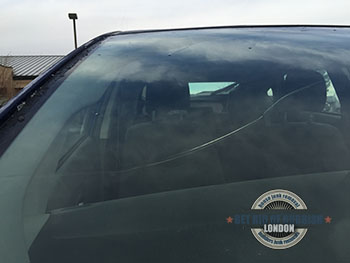Glass is a valuable material which the industry is looking to recycle as much as possible due to its physical and chemical properties, and its increasing number of uses in the modern world. Recycling of glass after rubbish removal and disposal is not that much of a problem, though when it comes to specific types of glass, the situation is somewhat different and more complex. One of the types of glass that is not generally recycled is the one used for the making of automobile windscreens (the front window of the vehicle). Most people would have seen the web-like appearance of a shattered windscreen – this is the main issue for recycling this type of glass.
 Unlike its side and back counterparts which shatter to tiny bits in case of impact in order to prevent serious injury, the windscreen is engineered not to fall to bits in case of impact but to stay as one piece (even though shattered). This is achieved by attaching two outer layers of specially formulated glass, by a binding layer of flexible resin in the middle. The resin which is made of Polyvinyl Butyral or PVB for short is effectively sandwiched between the top and bottom layer of glass so when an impact occurs, the glass on either side shatters, but is held together by the PVB resin layer in the middle.
Unlike its side and back counterparts which shatter to tiny bits in case of impact in order to prevent serious injury, the windscreen is engineered not to fall to bits in case of impact but to stay as one piece (even though shattered). This is achieved by attaching two outer layers of specially formulated glass, by a binding layer of flexible resin in the middle. The resin which is made of Polyvinyl Butyral or PVB for short is effectively sandwiched between the top and bottom layer of glass so when an impact occurs, the glass on either side shatters, but is held together by the PVB resin layer in the middle.
This interlay of PVB is really hard to extract in the process of recycling laminated glass, plus the PVB itself is quite hard to repurpose. However, in twenty twelve, a collaboration between a windscreen maker and recycling company in the United States produced a very effective technology which created the method for recycling laminated glass almost entirely. Since it is hard and inefficient to try and separate the PVB inlay from the outer layers of glass, the entire windscreen is crushed using a special press to a very fine grade, in doing this the crusher machine separates the PVB from the glass. Almost ninety percent of the windscreen becomes what’s known as glass cullet. The material is quite versatile and used in the making of various glass products, including fibreglass insulation.
In the crushing and separation process, about seven percent of the windscreen become PVB scrap. The scrap is then made into pellets, in turn the pellets are included in the manufacturing of many different plastic products. Only a small percentage of the entire windscreen remains unusable in the form of rubber and other materials. In order to make the entire recycling process even more ecofriendly, the collection and transportation of waste windscreens is done in carbon-neutral way, using existing freight chains of that type. At the moment, the company collecting the windscreens from its branches across the US has achieved seventy percent return and recycle rate, hoping for it to reach hundred percent by the end of the year, or early twenty sixteen. In twenty fourteen, the company recycled one point three million windscreens, which diverted twenty three thousand tons of glass from landfill.
